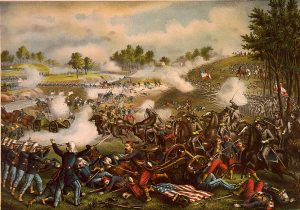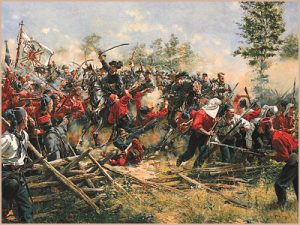 People don’t think of war as being something they want to send their children into…much less witness one themselves, or even one battle of a war. War really isn’t a spectator sport, after all. Nevertheless, there was a time, when people didn’t really seem to realize that. Early in the Civil War, the Union military command believed that the Confederate army could be easily defeated, and that the war would be over very quickly and with very little loss of life.
People don’t think of war as being something they want to send their children into…much less witness one themselves, or even one battle of a war. War really isn’t a spectator sport, after all. Nevertheless, there was a time, when people didn’t really seem to realize that. Early in the Civil War, the Union military command believed that the Confederate army could be easily defeated, and that the war would be over very quickly and with very little loss of life.
In July of 1861, the folly of that overconfidence was sharply pointed out when General Irvin McDowell led a premature offensive into northern Virginia. He set out in search of the Confederate forces, leading 34,000 mostly inexperienced troops, who were also poorly trained, toward the railroad junction of Manassas, which is just 30 miles from Washington DC. General Beauregard of the Confederate forces, was alerted of the advance, and so brought together 20,000 troops there. He was soon joined by General Joseph Johnston, who brought 9,000 additional men by way of railroad.
On the morning of July 21, 1861, the people of the area heard of the opposing forces, and that a battle was about to break out in their vicinity. Hundreds of civilian men, women, and children turned up to watch the first major battle of the Civil War. The fighting commenced with three Union divisions crossing the Bull Run stream. The Confederate flank was driven back to Henry House Hill. General Beauregard had set up a strong defensive line backed up by a brigade of Virginia infantry under General Thomas Jackson. From a concealed slope, Jackson’s men began firing a series of Federal charges. It was this plan that gave Jackson his famous nickname Stonewall. The Confederate cavalry under J.E.B. Stuart captured the Union artillery, and General Beauregard ordered a counterattack on the exposed Union right flank. The rebels came charging down the hill, yelling furiously, and General McDowell’s line was broken, forcing his troops in a hasty retreat across Bull Run. The retreat soon became an all out run for their lives, and supplies littered the road back to Washington. Union forces endured a loss of 3,000 men killed, wounded, or missing in action while the Confederates suffered 2,000 casualties in the bloody battle.
The horrific battle not only the frightened spectators at Bull Run, but the United States government in Washington as well, which was faced with an uncertain military strategy that would obviously need to change, if the South was to be stopped. I have a hard time understanding how the people could possibly have thought this was something to go out and watch…much less to take their children to. Of course, these days I think we have seen so much war on television, that no one in their right mind would go to watch a battle and no one would take their kids, because war is not a spectator sport.


Leave a Reply